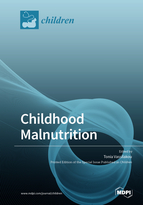Childhood Malnutrition
A special issue of Children (ISSN 2227-9067). This special issue belongs to the section "Global and Public Health".
Deadline for manuscript submissions: closed (31 May 2023) | Viewed by 46183
Special Issue Editor
Interests: nutritional knowledge and behavior of children and adolescents; childhood obesity; lifestyle medicine; diet; exercise; sleep; dietary supplements; smoking cessation; medical nutrition therapy; diabetes; epilepsy
Special Issues, Collections and Topics in MDPI journals
Special Issue Information
Dear Colleagues,
This Special Issue, “Childhood Malnutrition”, will focus on malnutrition, including undernutrition, overweight, and obesity, in infants, children, and adolescents. Malnutrition among children and adolescents is a major public health problem. In 2019, globally, 144 million children under the age of 5 years were stunted, 47 million were wasted, and 38 million were overweight. Poor availability or access to food of adequate nutritional quality has led large population sections to be undernourished, have a poor nutritional status, or become overweight and obese. These conditions often present simultaneously and are interconnected. A healthy diet beginning in the early stages of life results in adequate energy and nutrient intake and healthy weight and is crucial for the physical, mental, and cognitive development of children and adolescents, as well as for their long-term health. This Special Issue will explore the genetic and environmental (e.g., lifestyle, psycho-social factors, etc.) determinants of malnutrition in children, focusing on relevant methodological considerations, dietary recommendations, health interventions, and public health policy actions. Various types of articles, such as original research, methodology, and review articles will be considered for publication.
Prof. Dr. Tonia Vassilakou
Guest Editor
Manuscript Submission Information
Manuscripts should be submitted online at www.mdpi.com by registering and logging in to this website. Once you are registered, click here to go to the submission form. Manuscripts can be submitted until the deadline. All submissions that pass pre-check are peer-reviewed. Accepted papers will be published continuously in the journal (as soon as accepted) and will be listed together on the special issue website. Research articles, review articles as well as short communications are invited. For planned papers, a title and short abstract (about 100 words) can be sent to the Editorial Office for announcement on this website.
Submitted manuscripts should not have been published previously, nor be under consideration for publication elsewhere (except conference proceedings papers). All manuscripts are thoroughly refereed through a single-blind peer-review process. A guide for authors and other relevant information for submission of manuscripts is available on the Instructions for Authors page. Children is an international peer-reviewed open access monthly journal published by MDPI.
Please visit the Instructions for Authors page before submitting a manuscript. The Article Processing Charge (APC) for publication in this open access journal is 2400 CHF (Swiss Francs). Submitted papers should be well formatted and use good English. Authors may use MDPI's English editing service prior to publication or during author revisions.
Keywords
- malnutrition
- undernutrition
- overweight
- obesity
- food availability
- healthy diet







